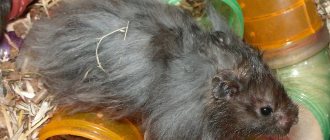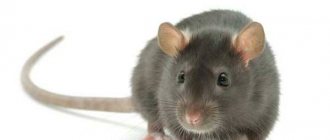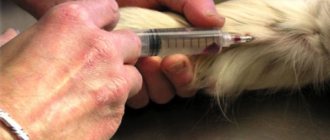Is it possible to bathe rats
Some rat owners believe that they should not bathe their furry rats because they are afraid of water and do not know how to swim. Such fears are unfounded. After all, the wild relatives of cute rodents feel great in the aquatic environment - they swim, frolic and even hunt in reservoirs. Therefore, bathing will bring not only benefits to your pet, but also positive emotions.
The main thing is to act carefully during hygiene procedures and not harm your pet. You will have to prepare especially carefully for your first swim. Perhaps your pet will start biting or scratching out of habit. In such a situation, it is better to interrupt the water procedures and postpone washing until the next day.
When your pet is taking a bath, you need to make sure that water does not accidentally get into his ears. When deliberately diving, rodents manage to block the ear canals. But if the rat does not have time to do this, and the fluid gets into the ears, the fluffy one will most likely face otitis media.
Precautionary measures
If a rat appears at home and you have no experience caring for it yet, then you should prepare for certain difficulties that can be expected at certain stages. The most exciting moment will be bathing your pet, especially for the first time. To protect yourself, you should wear something with long sleeves, in case the animal is not in the mood or is not ready for contact with water. If possible, it is better to ask a qualified person to show you exactly how to bathe and tell you about all the nuances.
Precautionary measures should be taken not only in relation to the owner, but also for the pet itself. If the rat is still small and has not had the opportunity to get acquainted with water, it is necessary to create optimal conditions for this, evoking positive emotions from the new element. If you neglect these recommendations, it may be very difficult to wash your pet in the future, especially if it really needs it.
Although water procedures are carried out infrequently, it is necessary to know about those situations when they should not be used, otherwise there will be much more harm than good. It can be difficult for a non-specialist to notice any minor health problems in a pet, which is why life-threatening situations arise.
To avoid this if possible, it is worth knowing about the main reasons that prevent rats from bathing.
When should you wash your rat and how often?
Experienced rat breeders recommend bathing animals no more than 2-3 times a month. You can also carry out unscheduled washing in the following situations:
- Parasites were found in the animal’s fur;
- the pet is heavily soiled in its own waste, this is especially true if the rat suffers from a gastrointestinal disorder;
- the rodent's fur has a sharp, unpleasant odor;
- after a walk outside, the pet may get dirty or pick up ticks and other parasites;
- fluffy refuses to take care of his hygiene on his own - in general, rats are very clean, but there are exceptions;
- after contact of a rat with a stranger or animal, the foreign smell may be unpleasant for the animal;
- on the eve of an exhibition or any other important event.
It is also imperative to bathe a sick or older animal more often, which, due to physiological characteristics, is no longer able to care for itself.
Let's look at it in more detail
Cases when you can bathe this rodent:
- the rat ate something inedible and subsequently got dirty in it.
- from lying for a long time on a bedding that is no longer fresh, the pet smells unpleasant.
- the rat does not clean itself, does not wash itself, is unkempt (although this is rare, it can still happen)
- if the rat has parasites.
- The animal is already old, it is difficult for him to take care of himself, or due to illness.
- found in males: the rat's tail is unkempt.
- There are rats that simply love water treatments.
Preparation for water procedures
To prevent bathing from being chaotic, you should prepare in advance to perform hygiene measures. This will help both owner and pet feel more confident and relaxed.
Accessories
To bathe a rat, you need to prepare the following bath accessories:
- 2 shallow basins;
- a clean towel or soft baby diaper;
- a small washcloth (you can use a small piece of foam rubber or a cloth);
- a toothbrush with soft bristles.
Some rat owners ignore the use of a special bathing container, since washing their pet under running tap water is much more convenient.
However, this approach is quite dangerous, since the likelihood of liquid getting into the furry’s ears, eyes and nose greatly increases. In addition, there are often interruptions in the water supply, and icy or, conversely, very hot water may suddenly come out of the tap.
Bathing products
It is not recommended to wash rat fur with regular shampoos. Human hygiene products are too aggressive for the delicate skin of rodents and can cause irritation or dandruff. Therefore, it is better to buy a special rat shampoo, for example:
- Beaphar;
- Veda;
- Celandine;
- Le Artis;
- Shustrik.
Such products are inexpensive - in the range from 100 to 500 rubles. Moreover, one bottle lasts for about a year. In addition, most pet shampoos for rodents contain an anti-flea and tick component.
If your nearest pet store does not have a special shampoo for rats, you can order it online. Online stores offer a wide selection of specialized products for rodents.
Water level and temperature
To make swimming comfortable, you need to take care of the water temperature in advance. Ideally, the indicator should be +36-38ᵒС. It is best to use a special water thermometer to measure temperature. If the device is not at hand, you can immerse your elbow in the basin - the liquid should be warm, but in no case hot.
The water level in the improvised bath should be 3-5 cm - it is better to focus on the size of the rat. The main criterion is that the pet must calmly reach the bottom of the container with its paws, otherwise the animal may panic and try to escape from the basin.
For the psychological comfort of the fluffy, it is recommended to install a ladder in the bath, along which the pet can, if necessary, leave the container on its own.
Some rats love water from birth and are ready to swim every day. In such cases, it is allowed to pour more liquid into the basin so that the pet can frolic to its heart’s content and swim freely. Only the owner must closely monitor the rat, and at the first signs of fatigue, pull the animal out of the water.
Traditional plastic carrier
Perhaps the most common way to move small animals. Very well suited for long-distance travel, but in a car (and especially on a bicycle) a bulky plastic box is not very convenient.
Among the advantages, we note excellent breathability, ease of cleaning and maintenance, the ability to organize meals while traveling, hygiene, strength and durability.
The disadvantages are determined by the need to allocate space for storing this box and, of course, the outdated design. It is necessary to have such a device in stock, but it is not very suitable for short-term forays outside the city.
Cost – 1,146 – 2,137 rubles.
How to properly wash a rat
In order for bathing to be successful, you will need to familiarize yourself in advance with the procedure for carrying out hygiene procedures. The main thing is to act consistently and confidently.
Bathing
To bathe, you will need to fill 2 basins with water at once. In one, you will need to bathe the rat using shampoo. And in the second, with clean water, you will need to immerse the animal to thoroughly rinse the fur. It is better to carry out the procedure in the bathroom or in any other room protected from drafts so that the animal does not catch a cold.
Before washing, you need to make sure that the pet is in a good mood, calm and does not mind spending time together with the owner. When the rat is ready, you will need to follow a few simple steps:
- Carefully take the fluffy in your hands and bring it to a bowl of water. If the animal sees the container for the first time, you need to let him sniff the bath.
- Carefully immerse the rat in the water, while slightly raising its muzzle.
- Wait 1-2 minutes, then gradually remove your hand so that the fluffy touches the bottom with its paws.
- Pour a small amount of your chosen shampoo onto wet palms and lather.
- Gently work the animal's fur with your hands, paying special attention to the back half of the body - if the animal is heavily soiled, it is better to use a small washcloth or cloth.
- Place the rat in a container of clean water and thoroughly rinse the fur to remove any foam.
You will also need to clean the animal's tail, this is especially true for males. To clean, you need to treat the tail part with a soft toothbrush, moving from the base to the tip. In this case, you need to act without pressure and under no circumstances rub the delicate skin.
If the rat itself is clean, and only the tail is dirty, it is not necessary to bathe the pet completely. It is enough to slightly soak the stains by applying damp cotton swabs for 5-10 minutes. After that, also treat the tail with a toothbrush and rinse with clean water. At the end of the procedure, you will need to wipe the ponytail with a towel and treat it with baby cream.
Drying
Rats are prone to developing colds. Therefore, after bathing, the animal’s fur should not remain wet; it should be dried as soon as possible. A towel or any soft fabric that absorbs moisture well is perfect for these purposes.
To thoroughly dry the fur, you need to wrap the bathed rat in a previously prepared towel. Then blot the wool until it is completely dry. This is very important, since a pet with a wet coat can easily catch a cold even in summer.
Some rat owners try to dry their pet with a hairdryer after bathing. Such drying is strictly prohibited - the animal will receive severe stress from the loud sound and the flow of hot air.
What to do if the animal is afraid, bites and breaks out
By its nature, the decorative rat is completely non-aggressive. Although there are some exceptions. But, nevertheless, in many cases, bites are not a manifestation of anger, but a defensive reaction. Therefore, you need to understand the question of why the animal began to bite.
If the little rat had not bitten before, and then began to do so, then most likely your behavior or that of your family members has shaken his trust. Remember if you have pushed, pinched or stepped on an animal recently. Such actions, like physical punishment, can cause not only a desire to bite, but also fear. In addition, a tamed animal can escape from one’s hands, although there were no problems before. Physical pain for a pet is a threat to it, so this behavior is a defensive reaction of the rat.
Bites can mean many things:
- interest - the animal gently nibbles with its teeth;
- thirst for affection - bites as if biting off the fur of a relative;
- showing superiority - trying to show with a bite who is in charge in the family;
- attracting attention - a sudden bite from an unexpectedly visiting pet;
- playful mood - bites, runs away and comes back;
- warning - a response to your actions, as an option it hurts him;
- fright - after a bite the pet runs, breathes heavily, wants to hide.
During puberty (at 5–7 months of life), males may begin to bite, hiss and snort. This is hormonal maturation, growing up and defending territory. Females mainly bite when they are pregnant or caring for pups.
Also find out how to teach a rat to go to the toilet in a litter tray.
To prevent your pet from becoming aggressive, you need to:
- provide the rat with peace during the adaptation period;
- do not insert food or fingers between the cage bars, only through the door;
- play with the animal every day;
- reduce the noise level around your pet;
- Do not hit the rat under any circumstances.
Any attempts to bite must be stopped. If a rat bites, drive it away from you. She will quickly understand that this cannot be done. If a rat bites you, you must squeeze out the blood from the wound to prevent inflammation, treat it with peroxide and an antiseptic. You can visit the hospital if you wish. The main thing is that the animal is vaccinated.
How to accustom a rat to water
The first bath for a rat is always stressful, because it has never been immersed in water before. To minimize psychological discomfort from water procedures, you should teach your pet to wash in advance. The ideal age for bath training is 6-7 weeks. The whole process is divided into several stages:
- Getting to know water. For the first time, the liquid must be poured into a small plastic container. The water level should be only 1-1.5 cm. It is recommended to place something interesting at the bottom that will attract the attention of the rodent. For example, sea stones or shiny coins. When the rat enters the water, do not touch it. Let the animal look around and get used to the sound of the water. The optimal time spent in the bath is 3-5 minutes. To develop positive emotions, you should offer your fluffy his favorite treat before he leaves the water container.
- Consolidation of the achieved result. If the first acquaintance with water was successful, you will need to repeat the procedure 2-3 more times with a week break. Moreover, each subsequent time you need to pour a little more water, increasing the liquid level by 0.5-1 cm. And only after that you can move on to the next step.
- Immersion in a larger container - a basin or a special bathtub (you can buy it at a pet store). In this case, it is recommended to place a small wooden block in the water, which the rat can easily climb on if it feels the slightest discomfort. You should not use shampoo at this stage; let your pet frolic a little and splash around on its own. To exit the water, you need to install a ladder or bridge. Fluffy must understand that he can stop bathing at any time.
- Direct washing. As soon as the owner feels that the rat is not afraid of water and enjoys visiting the bathroom, you can start using specialized shampoos. In this case, you need to make sure that the foam does not get into the mouth or eyes, otherwise the animal may get scared and the achieved results will be canceled.
It is a little easier for owners of several rats to cope with the task. Because a newly acquired pet can first be shown how its cage neighbors bathe. This way the baby will understand that there is no danger in the water, and the duration of the learning process will be significantly reduced.
Do they like to swim?
We all know that in natural conditions rats show themselves to be excellent swimmers, but domesticated animals have nothing in common with these characteristics. Fluffy pets, on the contrary, are afraid of water, no matter how strange it may be, they experience great stress and fear while bathing. Therefore, experienced breeders recommend introducing rodents to water at an early age so that they perceive this procedure normally.
If we return to wild relatives who have excellent swimming abilities, there are some more points worth noting. They are excellent divers, can stay in water for up to 3 days, and also hunt underwater. But at the same time, they never use water for hygiene purposes.
They take care of themselves with the help of their paws and teeth, and also use sand as baths. Therefore, even in the wild, beautiful swimmers will not climb into the water unless absolutely necessary. Of course, there are individuals who simply love water, they are also found among pets, but there are much fewer of them who cannot stand it.
In many ways, the bathing procedure, as well as the frequency, depends directly on the owners. If they keep the animal in normal conditions, carry out regular cleaning and provide proper care, then there is no need for water procedures.
But remember, if the need for bathing does arise, this process must be approached very seriously and responsibly so as not to cause stress in the animal and harm its health.
When is it prohibited to bathe a rat?
Despite all the benefits of water procedures, in some situations it is necessary to avoid bathing your rat. The unfavorable factors are:
- the presence of colds - staying in water can only aggravate the course of the disease, and treating rats is very difficult;
- immediately after moving a pet to a new place of residence - first the animal must look around and adapt to the new environment;
- in the postoperative period - bathing should be postponed until the sutures have completely healed;
- if there are abrasions, scratches, or small wounds on the rodent’s body, shampoo that gets on the damaged skin can easily cause irritation and itching;
- the animal is in a bad mood, unreasonable aggression or lethargy - it is better to postpone water treatments to another day.
If you can’t bathe your pet, but its fur is very dirty or a specific smell has appeared, there is still a way out of the situation. You can carry out hygiene measures in a simplified manner. To do this, you need to moisten a soft, clean cloth with warm water and gently wipe the pet, moving from the withers to the tail. After that, dry the rat’s fur with a soft cloth. It is not recommended to wash with water, since the foam cannot be removed without water.
Every owner of a decorative rodent should know how to properly organize bathing and how often to wash a pet rat. This will ensure not only a high level of personal hygiene for the animal, but will also become the key to a trusting and affectionate relationship with the owner.
Will bathing help get rid of the strong male odor?
The sebum of pet rats can be a nightmare for male owners. The lubricant produced by the sebaceous glands of rats can accumulate on them over time and produce a very strong unpleasant odor. This scent helps males mark their territory. Odorous sebum can definitely be washed off, but bathing your rat too often will only increase its production. This, in turn, will lead to an increase in the unpleasant odor. Castrating the male is the most effective way to solve this problem.
How to wash your dog if you run out of shampoo
It also happens that the special shampoo for dogs has run out, and the pet urgently needs to be washed. No need to grab soap and shampoo for people! For such emergencies, proven home recipes are suitable. The ingredients for these recipes are quite simple and can be found in every home.
Homemade natural recipes
Recipe 1
The shampoo has antibacterial and deodorizing properties.
Ingredients:
- white vinegar - 1/2 cup;
- dishwashing liquid – ¼ cup;
- warm water – 2 glasses.
Mix all ingredients in a spray can and shake well to mix. Wet your dog's fur and apply the resulting product evenly, whipping up a thick foam. Rinse your dog's coat thoroughly and dry it.
Recipe 2
The shampoo is recommended for pets with dry and sensitive skin.
Ingredients:
- oatmeal – 1 cup;
- baking soda – 1/2 cup;
- warm water – 1 liter.
Grind the oatmeal in a coffee grinder until it becomes flour. Pour it into a deep bowl and mix with soda. Pour in water and mix well. Wet your dog's coat and apply homemade shampoo evenly. Leave it on for a few minutes, then rinse off with warm water. Dry the coat thoroughly.
Is it possible to wash a dog with baby shampoo?
It is known that baby bath products have a softer and more gentle formula, so we can assume that it is allowed to wash dogs with baby shampoo. In fact, you don't need to do this! Such bathing can lead to itching and dandruff in your pet. If there is no special “dog” remedy, it is better to refer to our home recipes.
Is ultrasound effective?
Specialized stores offer ultrasonic devices that, according to manufacturers, repel rodents. Indeed, rats and mice perceive ultrasound, and certain frequencies cause anxiety and even panic in them. This option is considered by many to be the most acceptable, but to ensure results, several factors must be taken into account:
- purchase high-quality and powerful devices, avoid useless counterfeits;
- the device must distribute sound evenly in all directions;
- It is desirable that the ultrasound frequency changes automatically, so it will be more difficult for rodents to get used to it.
You should also remember the disadvantages.
- Firstly, despite the fact that people do not hear high-frequency sounds, prolonged exposure to radiation can cause deterioration of health and headaches for some.
- Secondly, ultrasound is heard by hamsters, dogs and cats, so the device can both scare away rats and cause discomfort to pets.










